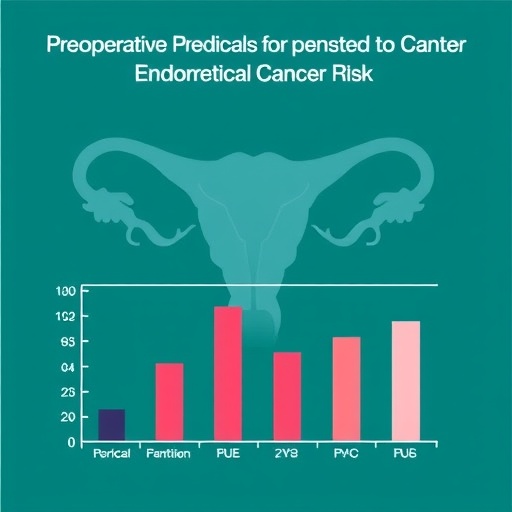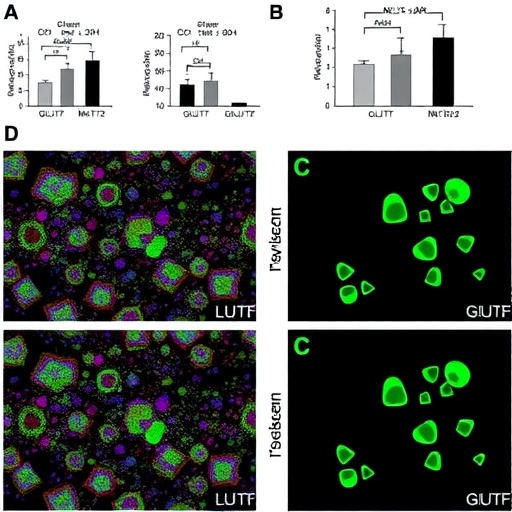
In a groundbreaking study published in BMC Cancer, researchers have unveiled preoperative factors that predict the presence of endometrial carcinoma (EC) in patients initially diagnosed with endometrial intraepithelial neoplasia (EIN). This advancement provides critical insight into surgical decision-making, particularly regarding the necessity of lymph node dissection (LND) during hysterectomy procedures. With endometrial cancer remaining one of the most common gynecologic malignancies worldwide, identifying high-risk patients before surgery is an imperative step towards personalized and effective treatment.
Endometrial intraepithelial neoplasia represents a precancerous condition characterized by cellular atypia within the endometrial lining. However, a significant proportion of patients diagnosed with EIN harbor concurrent occult endometrial carcinoma, which is often only discovered upon postoperative histopathological examination. This diagnostic uncertainty challenges surgeons in planning the extent and aggressiveness of operative management, especially when considering the risks and benefits of performing lymphadenectomy or sentinel lymph node biopsy.
The study analyzed a cohort of 172 patients treated between June 2020 and December 2024 by gynecologic oncology surgeons. These individuals had been preoperatively diagnosed with EIN and subsequently underwent hysterectomy. Comprehensive clinical data—including demographic characteristics, imaging evaluations, intraoperative findings, and detailed pathology reports—were meticulously compiled for statistical analysis. The primary objective was to discern variables correlating significantly with the presence of hidden endometrial carcinoma.
Among the pivotal findings, age emerged as a formidable predictor. Patients aged 50 years and above demonstrated nearly a fourfold increased odds (OR = 3.94) of harboring endometrial carcinoma compared to younger counterparts. This age threshold aligns with the biological transition through menopause, implicating hormonal changes in carcinogenesis. Notably, postmenopausal status independently conveyed heightened risk, underscoring the complex interplay between endocrine milieu and endometrial cellular transformation.
Comorbidities such as diabetes mellitus and hypertension also revealed robust associations with occult endometrial carcinoma. The presence of diabetes doubled the likelihood (OR: 2.35), while hypertension increased it by approximately two and a half times (OR: 2.54). These conditions are often linked to metabolic syndrome, systemic inflammation, and vascular alterations, all of which may contribute to tumorigenesis in the endometrial microenvironment.
Body mass index (BMI), a modifiable clinical parameter, was found to be significantly related to cancer risk. A BMI of 35 kg/m² or greater was correlated with the presence of concurrent carcinoma, likely due to the influence of adipose tissue on estrogen production and chronic inflammatory signaling pathways. This finding reinforces the need for weight management strategies as part of comprehensive gynecologic cancer prevention efforts.
Endometrial thickness (ET), assessed through imaging modalities such as transvaginal ultrasound, served as a potent non-invasive marker. An ET measurement equal to or exceeding 14 millimeters quadrupled the odds (adjusted OR: 4.06) of detecting carcinoma upon pathological review. This metric offers clinicians a valuable diagnostic cue to augment preoperative risk stratification, potentially influencing the scope of surgical intervention.
The Mayo criteria, a well-established set of parameters guiding the necessity for lymph node dissection, were validated in this study cohort. Approximately 62% of patients who ultimately were diagnosed with endometrial carcinoma satisfied the criteria, indicating a substantial subset likely benefiting from lymph node assessment. Incorporating these criteria alongside the newly identified predictors may refine the selection process for LND, balancing oncologic thoroughness with surgical morbidity.
This research highlights the imperative for multidisciplinary collaboration between gynecologists, oncologists, radiologists, and pathologists in the preoperative evaluation of patients with EIN. By integrating clinical, metabolic, and imaging data, treatment plans can be better tailored to individual risk profiles. Such personalized approaches promise to optimize surgical outcomes while minimizing unnecessary procedures.
The implications extend beyond surgical planning; recognizing these predictors also opens avenues for enhanced screening and surveillance protocols. Patients exhibiting several of these risk factors may warrant intensified monitoring or even consideration of primary medical therapies. Conversely, low-risk individuals might avoid overtreatment, preserving reproductive potential and quality of life.
Technological advancements in imaging, coupled with novel biomarkers and molecular diagnostics, could further augment the predictive accuracy described in this study. Future investigations might explore the integration of genomic profiling with conventional risk factors, advancing precision medicine in gynecologic oncology.
Moreover, the study underscores the relevance of addressing modifiable lifestyle factors such as obesity and metabolic health in the broader landscape of endometrial cancer prevention. Public health initiatives targeting metabolic syndrome components could contribute to reducing disease burden at the population level.
In summary, the identification of age ≥50 years, postmenopausal status, diabetes, hypertension, BMI ≥35 kg/m², and endometrial thickness ≥14 mm as strong preoperative predictors marks a significant step forward. Patients exhibiting these parameters should be prioritized for referral to specialized gynecologic oncology services where comprehensive lymph node evaluation, including lymphadenectomy or sentinel lymph node biopsy, can be judiciously considered.
This evidence-based framework empowers clinicians to navigate the clinical dilemma inherent in EIN management, transforming surgical decision-making from reactive to proactive. Ultimately, it paves the way toward improved prognostication, individualized care, and better survival outcomes for women facing endometrial neoplastic disease.
Subject of Research: Preoperative predictors of endometrial carcinoma in patients with endometrial intraepithelial neoplasia undergoing hysterectomy.
Article Title: Preoperative predictors of endometrial carcinoma in patients undergoing hysterectomy for endometrial intraepithelial neoplasia.
Article References:
Çaltek, N.Ç., Çaltek, H.Ö., Yassa, M. et al. Preoperative predictors of endometrial carcinoma in patients undergoing hysterectomy for endometrial intraepithelial neoplasia. BMC Cancer 25, 883 (2025). https://doi.org/10.1186/s12885-025-14312-8
Image Credits: Scienmag.com
DOI: https://doi.org/10.1186/s12885-025-14312-8
Tags: clinical data analysis in cancer researchendometrial intraepithelial neoplasia diagnosisgynecologic malignancies prevalencehistopathological examination in cancer diagnosishysterectomy outcomes in EIN patientslymph node dissection in endometrial canceroccult endometrial carcinoma detectionpersonalized treatment for endometrial cancerpreoperative factors for cancer risk assessmentpreoperative predictors of endometrial cancersignificance of lymphadenectomy in surgerysurgical decision-making in gynecologic oncology





